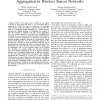Free Online Productivity Tools
i2Speak
i2Symbol
i2OCR
iTex2Img
iWeb2Print
iWeb2Shot
i2Type
iPdf2Split
iPdf2Merge
i2Bopomofo
i2Arabic
i2Style
i2Image
i2PDF
iLatex2Rtf
Sci2ools
119
click to vote
SECON
2008
IEEE
2008
IEEE
Enhancing the Data Collection Rate of Tree-Based Aggregation in Wireless Sensor Networks
— What is the fastest rate at which we can collect a stream of aggregated data from a set of wireless sensors organized as a tree? We explore a hierarchy of techniques using realistic simulation models to address this question. We begin by considering TDMA scheduling on a single channel, reducing the original problem to minimizing the number of time slots needed to schedule each link of the aggregation tree. The second technique is to combine the scheduling with transmission power control to reduce the effects of interference. To better cope with interference, we then study the impact of utilizing multiple frequency channels by introducing a simple receiver-based frequency and time scheduling approach. We find that for networks of about a hundred nodes, the use of multi-frequency scheduling can suffice to eliminate most of the interference. The data collection rate then becomes limited not by interference, but by the maximum degree of the routing tree. Therefore we consider finall...
Related Content
| Added | 01 Jun 2010 |
| Updated | 01 Jun 2010 |
| Type | Conference |
| Year | 2008 |
| Where | SECON |
| Authors | Özlem Durmaz Incel, Bhaskar Krishnamachari |
Comments (0)

